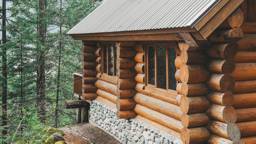
Log home insurance expert Fred Roberts answers the most frequently asked coverage questions, so you can have the peace of mind that your log home investment will be well protected.
Lets start at the beginning: What insurance do homeowners need during log home construction, and when should they get it?
“Builders-risk” insurance is the primary means to insure for property exposure claims during construction. Builders- risk insurance is active while projects are under construction, renovation, remodel or repair. It’s best to secure builders-risk insurance prior to starting the project. In the case of a construction loan, builders-risk insurance is normally required before the loan closing date.
What does builders-risk insurance cover?
A simple way to look at builders-risk is to consider it like homeowners insurance but without personal-contents coverage. This type of policy covers the structure and materials during the construction phase only. It can cover certain types of loss, damage or destruction of property, but it excludes coverage for claims of defective work or design. Liability is normally not a part of a builders-risk policy, but your agent should be able to provide a standalone liability policy. Keep in mind that this liability policy is not a replacement for workers comp and accident coverage for your workers or subcontractors.
How long does a builders-risk policy generally last?
It’s 12-month insurance coverage that normally ends at the end of the 12th month, usually without possibility of renewal; but in some cases, an insurance carrier will allow one 12-month renewal for the same premium as the cost of initial policy. Another possibility is vacant-dwelling coverage, which is pretty costly, but can be a good option if only 30 or 60 additional days are required to complete the home. Log homes’ completion period is shorter than a conventional home’s, which involves many more steps to reach similar results. So, if your builders-risk carrier can roll the policy over to a dwelling policy, you often can achieve a substantial savings overall.
When does the homeowner’s policy take over?
Once the construction phase of your home is completed and you are ready to occupy, you will then need to have homeowners or dwelling coverage in place. I recommend having a policy ready to start a couple of weeks in advance to avoid surprises.
What makes some insurers hesitant to insure log homes or rural homes?
The reluctance by carriers to cover log or rural homes comes from a lack of knowledge, not from increased risk. The log home industry is a specialty area and, even though more and more people are realizing the ad- vantages of log home living, the percentage of log homes in the market is still small in comparison to conventional construction. I recommend dealing with insurance agents who are familiar with rural or log home insurance for a smoother experience.
Do log homes present an insurance risk?
Log homes are not any greater insurance risk than conventional homes. It all comes down to location; the distance to a fire department and hydrant; and how familiar your agent is with log homes. If your home, whether brick or log, is 20 miles from a fire department and five miles down a winding dirt road over two mountaintops, your rate will be higher than it would be for a house along a busy city street (but the view won’t be nearly as spectacular).
Are there things log homeowners can do to mitigate risks?
Yes. To help mitigate risk for log homes, it’s wise to do the following:
-
Purchase your log home from a known log home manufacturer
-
Obtain insurance coverage from an agent familiar with log homes, and
-
Build your home within five miles radius of a fire department.
Does it cost more to insure a log home?
Not necessarily, but three things that can increase rates on your log home insurance coverage: Using an insurance agent unfamiliar with log homes, location and overall roof age and condition.
Is a new log home easier to insure than an older one?
There’s no difference in insuring a new log home versus an older log home, as long as roof, electrical and plumbing have been updated and an overall good condition has been maintained.











